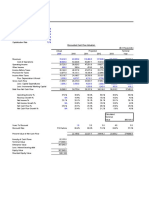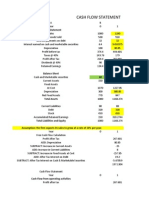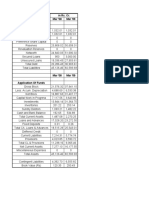Excel Financial Modelling Examples Chapter 1
Uploaded by
sachin_chawlaExcel Financial Modelling Examples Chapter 1
Uploaded by
sachin_chawladiscount rate present value
10% $37,907.87
year 1 2 3 4 5
cash flow 10000 10000 10000 10000 10000
financial modeling by simon benninga
discount rate present value
10% ($2,092.13)
year 0 1 2 3 4 5
cash flow -40000 10000 10000 10000 10000 10000
discount rate present value IRR
10% ($2,092.13) 8%
year 0 1 2 3 4 5
cash flow -40000 10000 10000 10000 10000 10000
COST IRR
1000 15%
LOAN TABLE
DIVISION OF PAYMENT BETWEEN INTEREST AND RETURN ON CAPITAL
YEAR 1 2 3 4 5 6
PRINCIPAL AT THE BEGINNING PAYMENT AT THE END 1000 850 777.5 744.125 255.74375 -605.8946875 300 200 150 600 900
INTEREST 150 127.5 116.625 111.61875 38.3615625
Consider an investment costing $1,000 today that pays off at the end of years 1, 2, , 5.
F PAYMENT BETWEEN INTEREST AND RETURN ON CAPITAL
PRINCIPAL 150 72.5 33.375 488.38125 861.6384375
PAYMENT AT THE END -1000 300 200 150 600 900 IRR 24%
MINUS 1000 IS ASSUMED TO SEE WHAT IF IN
00 IS ASSUMED TO SEE WHAT IF INVESTMENT IS SOLD AT THE BEGINNING IT IS NECESSARY FOR CALCULATING IRR
COST IRR
1000 24%
Consider an investment costing $1,000 today
YEAR 1 2 3 4 5 6
LOAN TABLE PRINCIPAL AT THE BEGINNING PAYMENT AT INTEREST THE ENDPRINCIPAL 1000 940 965.6 1047.344 698.70656 -33.6038656 300 240 200 225.6 150 231.744 600 251.3626 900 167.6896
DIVISION OF PAYMENT BETWEEN INTEREST AND RETURN ON CAPITAL
60 -25.6 -81.744 348.63744 732.3104256
MULTIPLE INTERNAL RATE OF RETURN DISCOUNT RATE NPV 6% ($3.76) CASH FLOW 0 1 2 3 4 5 -145 100 100 100 100 -275
YEAR
IRR 1 IRR 2
9% 27%
FLAT PAYMENT SCHEDULE
LOAN PRINCIPAL INTEREST RATE LONG TERM ANNUAL PAYMENT
10000 7% 6 $2,097.96
Notice that we have put "PV"Excel's nome returns a negative payment (a minor irritant
You can confirm that this answer is correct by creating a loan table:
LOAN PRINCIPAL INTEREST RATE LONG TERM ANNUAL PAYMENT
10000 7% 6 $2,097.96
YEAR
PRINCIPAL AT THE PAYMENT BEGINNING AT THE END OF THE YEAR OF YEAR
SPLIT PAYMENT INFORMATION INTEREST 700 602.1428 497.4356 385.3989 265.5196 137.2488
1 2 3 4 5 6
10000 8602.04 7106.2228 5505.698396 3793.137284 1960.696894
2097.96 2097.96 2097.96 2097.96 2097.96 2097.96
PAYMENT SCHEDULE
we have put "PV"Excel's nomenclature for the initial loan principalwith a minus sign. Otherwise Excel gative payment (a minor irritant).
SPLIT PAYMENT INFORMATION RETURN OF PRINCIPAL 1397.96 1495.817 1600.524 1712.561 1832.44 1960.711
Future Values and Applications AMOUNT TO BE DEPOSITED INTEREST TIME PERIOD
1000 10% 10
FUTURE VALUE
$2,593.74
FUTURE VALUE WIT ANNUAL DEPOSITS
INITIAL DEPOSIT AMOUNT TO BE DEPOSITED EACH YEAR TIME HORIZON INTEREST
1000 1000 10 10%
FUTURE VALUE
$17,531.17
Microsoft Excel 12.0 Answer Report Worksheet: [excel financial modelling examples.xlsx]PENSION PROBLEM Report Created: 7/25/2011 2:57:37 AM
Target Cell (Min) Cell Name $E$32 deposit at beginning year
Original Value Final Value 48000 0
Adjustable Cells Cell Name $E$32 deposit at beginning year
Original Value Final Value 48000 0
Constraints Cell Name $G$32 total in account in end of year $G$33 total in account in end of year $G$34 total in account in end of year $G$35 total in account in end of year $G$36 total in account in end of year $G$37 total in account in end of year $G$38 total in account in end of year $G$39 total in account in end of year $G$40 total in account in end of year $G$41 total in account in end of year $G$42 total in account in end of year $G$43 total in account in end of year $G$44 total in account in end of year
Cell Value 0 51840 107827.2 168293.376 233596.8461 219884.5938 205075.3613 189081.3902 171807.9014 153152.5335 133004.7362 111245.1151 87744.72427
Formula $G$32>=0 $G$33>=0 $G$34>=0 $G$35>=0 $G$36>=0 $G$37>=0 $G$38>=0 $G$39>=0 $G$40>=0 $G$41>=0 $G$42>=0 $G$43>=0 $G$44>=0
Status Binding Not Binding Not Binding Not Binding Not Binding Not Binding Not Binding Not Binding Not Binding Not Binding Not Binding Not Binding Not Binding
Slack 0 51840 107827.2 168293.376 233596.8461 219884.5938 205075.3613 189081.3902 171807.9014 153152.5335 133004.7362 111245.1151 87744.72427
interest annual deposit annual retirement withdrawel
8% 48000 30000
table without using solver:_
year 0 1 2 3 4 5 6 7 8 9 10 11 12
account balance beg-year 0 51840 107827.2 168293.4 233596.8 304124.6 296054.6 287338.9 277926 267760.1 256780.9 244923.4 232117.3
interest deposit at earned beginning during year year 48000 48000 48000 48000 48000 -30000 -30000 -30000 -30000 -30000 -30000 -30000 -30000 3840 7987.2 12466.18 17303.47 22527.75 21929.97 21284.36 20587.11 19834.08 19020.81 18142.47 17193.87 16169.38
table with using solver to see accurate result
year 0 1 2 3 4 5 6 7 8 9 10 11 12
account balance beg-year 0 0 51840 107827.2 168293.4 233596.8 219884.6 205075.4 189081.4 171807.9 153152.5 133004.7 111245.1
interest deposit at earned beginning during year year 0 48000 48000 48000 48000 -30000 -30000 -30000 -30000 -30000 -30000 -30000 -30000 0 3840 7987.2 12466.18 17303.47 16287.75 15190.77 14006.03 12726.51 11344.63 9852.203 8240.379 6499.609
1.7 A Pension ProblemComplicating the Future Value Problem A typical exercise follows. You are 55 years old and intend to retire at age 60. To make your retiremen intend to start a retirement account. n At the beginning of each of years 0, 1, 2, , 4 (i.e., starting today and for each of the next four years) intend to make a deposit into the retirement account. You think that the account will earn 8 percent p n After retirement at age 60, you anticipate living eight more years.[3] During each of these years you withdraw $30,000 from your retirement account. Of course, account balances will continue to earn 8 p How much should you deposit annually in the account? The following spreadsheet fragment shows ho can go wrong in this kind of problemin this case, you've calculated that in order to provide $30,000 eight years, you need to contribute $240,000/5 = $48,000 in each of the first five years. As the spreads you'll end up with a lot of money at the end of eight years! (The reasonyou've ignored the powerful compound interest. If you set the interest rate in the spreadsheet equal to 0 percent, you'll see that yo
There are two ways to solve this problem. The first involves Excel's Solver. This can be found on the To
note:-
it is always necessary to give percentage sign when putting interest slover can be found in data tab at right side otherwise get it
total in account in end of year 51840 107827.2 168293.4 233596.8 304124.6 296054.6 287338.9 277926 267760.1 256780.9 244923.4 232117.3 218286.7
solver is used to see that how much minimum investment should m
>=
this mean greater than equal to zero
total in account in end of year 0 51840 107827.2 168293.4 233596.8 219884.6 205075.4 189081.4 171807.9 153152.5 133004.7 111245.1 87744.72
t age 60. To make your retirement easier, you
nd for each of the next four years), you the account will earn 8 percent per year. 3] During each of these years you want to balances will continue to earn 8 percent. g spreadsheet fragment shows how easily you that in order to provide $30,000 per year for the first five years. As the spreadsheet shows, onyou've ignored the powerful effects of ual to 0 percent, you'll see that you're right.)
olver. This can be found on the Tools menu.[
when putting interest tab at right side otherwise get it from loading it from add-ins
ch minimum investment should me made to achieve certail goals in future
greater than equal to zero
You might also like
- Financial Model Forecasting - Case StudyNo ratings yetFinancial Model Forecasting - Case Study15 pages
- Core Chapter 09 Excel Master 4th Edition StudentNo ratings yetCore Chapter 09 Excel Master 4th Edition Student77 pages
- Module 2 Introduction To Spreadsheets - Models PDFNo ratings yetModule 2 Introduction To Spreadsheets - Models PDF15 pages
- Effective Execution: Building High-Performing OrganizationsFrom EverandEffective Execution: Building High-Performing OrganizationsNo ratings yet
- Bank Valuation and Value Based Management: Deposit and Loan Pricing, Performance Evaluation, and Risk, 2nd EditionFrom EverandBank Valuation and Value Based Management: Deposit and Loan Pricing, Performance Evaluation, and Risk, 2nd Edition1/5 (1)
- Financial Modeling Course Outline - 16-17No ratings yetFinancial Modeling Course Outline - 16-173 pages
- Britannia Industries LTD Industry:Food and Dairy Products - MultinationalNo ratings yetBritannia Industries LTD Industry:Food and Dairy Products - Multinational22 pages
- Financial Modeling & Analysis Course, Ottawa - The Vair CompaniesNo ratings yetFinancial Modeling & Analysis Course, Ottawa - The Vair Companies4 pages
- Valuation The Big Picture: Aswath DamodaranNo ratings yetValuation The Big Picture: Aswath Damodaran106 pages
- Excel Skills - Loan Calculation & Analysis TemplateNo ratings yetExcel Skills - Loan Calculation & Analysis Template57 pages
- Kertas Kerja PPH 21 TER 2024 PahampajakNo ratings yetKertas Kerja PPH 21 TER 2024 Pahampajak194 pages
- Financial Model 3 Statement Model - Final - MotilalNo ratings yetFinancial Model 3 Statement Model - Final - Motilal13 pages
- Leverage Finance Template: Strictly ConfidentialNo ratings yetLeverage Finance Template: Strictly Confidential3 pages
- TRIAL Potato Chips Factory Financial Model Excel Template v.1.0No ratings yetTRIAL Potato Chips Factory Financial Model Excel Template v.1.084 pages
- DCF Valuation Model (EV and PE) : Free Cash Flow (FCF)No ratings yetDCF Valuation Model (EV and PE) : Free Cash Flow (FCF)15 pages
- Appropriations Dividend To Shareholders of Parent CompanyNo ratings yetAppropriations Dividend To Shareholders of Parent Company30 pages
- Advanced Financial Modeling Plus Merger & LBO Modeling (Finatics)No ratings yetAdvanced Financial Modeling Plus Merger & LBO Modeling (Finatics)4 pages
- Chapter 1: The Investment Environment: Problem SetsNo ratings yetChapter 1: The Investment Environment: Problem Sets6 pages
- BpmToolbox 6.0-Historical & Forecast Business Planning Model Example (Basic)No ratings yetBpmToolbox 6.0-Historical & Forecast Business Planning Model Example (Basic)66 pages
- Decoding DCF: A Beginner's Guide to Discounted Cash Flow AnalysisFrom EverandDecoding DCF: A Beginner's Guide to Discounted Cash Flow AnalysisNo ratings yet
- NEED FOR PROJECT APPRAISAL - October 15th, 2010No ratings yetNEED FOR PROJECT APPRAISAL - October 15th, 20101 page
- 10 December: Negativity Necessary For Constructive WorkNo ratings yet10 December: Negativity Necessary For Constructive Work3 pages
- Ifp 20 Fundamentals of Investment PlanningNo ratings yetIfp 20 Fundamentals of Investment Planning4 pages
- Ifp 36 Environment of A Financial PlannerNo ratings yetIfp 36 Environment of A Financial Planner8 pages
- Faridabad Telecom District: Account SummaryNo ratings yetFaridabad Telecom District: Account Summary1 page
- Romûlo Krafta: Definition and MeasurementNo ratings yetRomûlo Krafta: Definition and Measurement12 pages
- Class 11 Micro Economics Chapter 5 Notes PDFNo ratings yetClass 11 Micro Economics Chapter 5 Notes PDF5 pages
- MPSC Technical Agriculture Services Syllabus NewNo ratings yetMPSC Technical Agriculture Services Syllabus New13 pages
- Economics For Business Decisions: Consumer Behaviour, Demand and Supply Module-2No ratings yetEconomics For Business Decisions: Consumer Behaviour, Demand and Supply Module-2109 pages
- Mckinsey Quarterly - Thinking StrategicallyNo ratings yetMckinsey Quarterly - Thinking Strategically12 pages
- CH - 11visit Us at Management - Umakant.infoNo ratings yetCH - 11visit Us at Management - Umakant.info15 pages
- The Lucas Imperfect Information Model +++No ratings yetThe Lucas Imperfect Information Model +++5 pages
- Module 2 Introduction To Spreadsheets - Models PDFModule 2 Introduction To Spreadsheets - Models PDF
- Effective Execution: Building High-Performing OrganizationsFrom EverandEffective Execution: Building High-Performing Organizations
- Bank Valuation and Value Based Management: Deposit and Loan Pricing, Performance Evaluation, and Risk, 2nd EditionFrom EverandBank Valuation and Value Based Management: Deposit and Loan Pricing, Performance Evaluation, and Risk, 2nd Edition
- Britannia Industries LTD Industry:Food and Dairy Products - MultinationalBritannia Industries LTD Industry:Food and Dairy Products - Multinational
- Financial Modeling & Analysis Course, Ottawa - The Vair CompaniesFinancial Modeling & Analysis Course, Ottawa - The Vair Companies
- Excel Skills - Loan Calculation & Analysis TemplateExcel Skills - Loan Calculation & Analysis Template
- Financial Model 3 Statement Model - Final - MotilalFinancial Model 3 Statement Model - Final - Motilal
- TRIAL Potato Chips Factory Financial Model Excel Template v.1.0TRIAL Potato Chips Factory Financial Model Excel Template v.1.0
- DCF Valuation Model (EV and PE) : Free Cash Flow (FCF)DCF Valuation Model (EV and PE) : Free Cash Flow (FCF)
- Appropriations Dividend To Shareholders of Parent CompanyAppropriations Dividend To Shareholders of Parent Company
- Advanced Financial Modeling Plus Merger & LBO Modeling (Finatics)Advanced Financial Modeling Plus Merger & LBO Modeling (Finatics)
- Chapter 1: The Investment Environment: Problem SetsChapter 1: The Investment Environment: Problem Sets
- BpmToolbox 6.0-Historical & Forecast Business Planning Model Example (Basic)BpmToolbox 6.0-Historical & Forecast Business Planning Model Example (Basic)
- Decoding DCF: A Beginner's Guide to Discounted Cash Flow AnalysisFrom EverandDecoding DCF: A Beginner's Guide to Discounted Cash Flow Analysis
- 10 December: Negativity Necessary For Constructive Work10 December: Negativity Necessary For Constructive Work
- Economics For Business Decisions: Consumer Behaviour, Demand and Supply Module-2Economics For Business Decisions: Consumer Behaviour, Demand and Supply Module-2




































































































